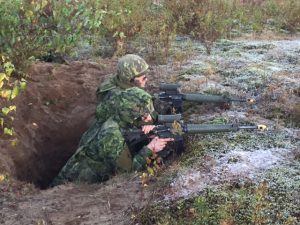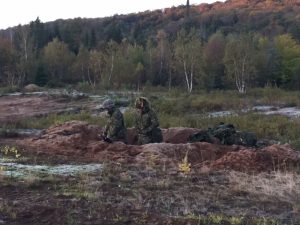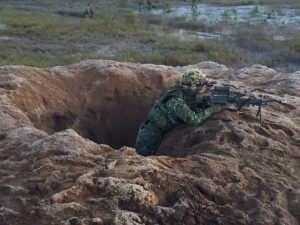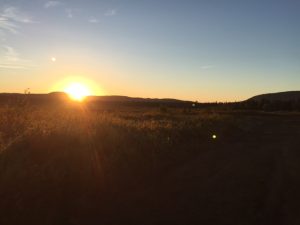Written by Private Katherine Forrest, a Rifleman in 9 Platoon, Charlie Company GPE

22 October 2015, Westmount, Quebec – If you ask an average civilian what they think of when you say “army training“, they might respond by saying “lots of shooting, the sound of explosions going off in the distance, people yelling orders, bodies being dragged back to safe points, etc”. While this type of moment driven action training is very important to the infantry, it is only a small percentage of what actually happens on GPE’s and in real combat (Editors note: “GPE” is the French acronym for “Groupe Principale d’Entrainement” which is the grouping together of soldiers from various units to form a composite rifle company of approximately 150 soldiers for training events).
The GPE that I took part in from the 25th to the 27th of September was a company level exercise that pulled together RMR, Blackwatch and CGG to develop fundamental skills of laying out a defensive position. It was the first time for most troops on the ground that the efforts of the exercise were concentrated on a defensive position and as well many years in which the RMR had ran a company level GPE. Therefore, everything that needed to happen took more time to organise.

During the GPE exercise, the participants along with myself stayed in hides overnight and during the day we worked at digging to level two trenches. At the end of the exercise we did a withdrawal from our position. While the long cold waits in the RV points and trenches might have been painful for some of the troops, it was a reality check that showed us how much planning and work goes into setting up defensive positions and what a real life operation might look like.
The biggest obstacle of this GPE for me was the weather. Trying to adjust my body temperature to the cold and learning how to layer for different activities was a challenge. Luckily I could look to more experienced members for advice on how to stay warm. I know that this is what most of the newly qualified infanteers did.
Another challenge was learning how to pack my rucksack. There was no transport to bring us to and from our positions so we had to carry everything we needed on our backs. We had to work together to share the loads and learn what is and what is not worth carrying.

For me the highlight of this GPE was on Saturday when we practised section attacks. There were a few newly PLQ qualified Corporals who were section commanders and section 2IC’s. They had the chance to run through section attacks and learn from more experienced Master Corporals and Sergeants. The first section attack we did was a little chaotic, some members were crossing into other people’s firing arc’s, some of us were struggling with stoppages while under contact and the section IC’s were all over the place with their orders. It took a few hours of practice but by lunch time I felt confident with how our section advanced to contact and I felt comfortable with the people I was working with.
This GPE was challenging for me and for many of the guys I was training with. The constant cold weather and the long hours of waiting took a toll on the morale of the troops. The exercise did however give us a chance to develop skills that some of us had never practised and that others had forgotten about. As infanteers, this exercise brought us back to our roots of digging trenches and ruck marching to our positions. It forced us to develop skills that some of the senior NCM’s said we had started to lose over the years of doing offensive operations.

This type of training will hopefully continue on the upcoming GPE’s run by the RMR. I am looking forward to next GPE where we will be continuing where we left off to further our knowledge of defensive operations.

